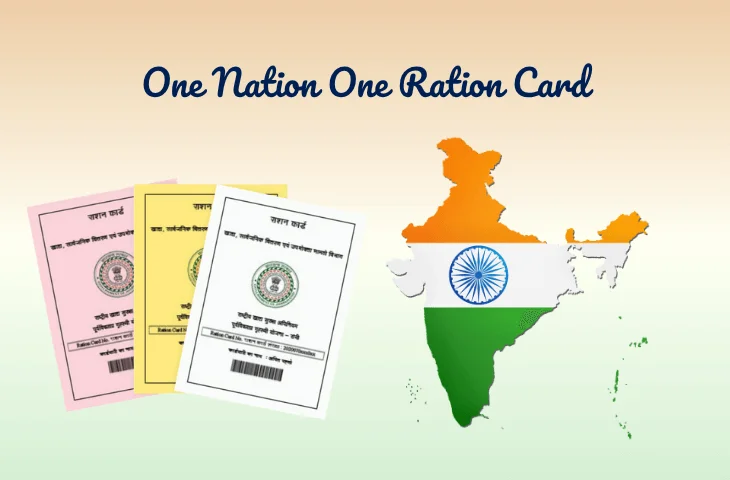The One Nation One Ration Card (ONORC) scheme is a transformative initiative by the Government of India. The scheme has been introduced to ensure food security for all citizens, particularly migrant workers, by allowing them to access subsidized food grains from any Fair Price Shop (FPS) in the country. Launched under the National Food Security Act (NFSA), 2013, this scheme leverages biometric and Aadhaar-based authentication to allow seamless portability of ration cards across states and districts.
The ONORC initiative was first implemented by Gujarat and, as of June 2022, has been successfully rolled out in all 36 States and Union Territories, making food security truly portable nationwide. The scheme integrates technology and digitization to create a transparent and efficient public distribution system (PDS).
Why was the ONORC Scheme Launched?
The scheme was launched to address several challenges faced by beneficiaries under the traditional PDS system:
- Limited access to food grains: Previously, ration cardholders could only access subsidized grains from their designated FPS in their home state.
- Migrant worker challenges: Migrants moving for work could not access their entitlements in other states.
- Leakages and corruption: Duplicate and fake ration cards led to inefficiency and corruption in the system.
- Social inclusion: Women, marginalized communities, and disadvantaged groups faced barriers in accessing PDS benefits.
By enabling interstate and intrastate portability, ONORC ensures that beneficiaries can claim full or partial entitlements from any FPS across India, thereby addressing these issues.
What is the Process of Ration Portability?
The ONORC scheme functions through a technology-driven approach:
- Biometric and Aadhaar Authentication: Beneficiaries authenticate themselves at any FPS using fingerprint or iris scans linked to their Aadhaar number.
- Digital Integration: The Integrated Management of Public Distribution System (IM-PDS) portal connects PDS networks across states to enable portability.
- Partial Claims: Migrants can claim a portion of their entitled food grains at their current location, while family members back home can access the remaining share.
- ePoS Devices: Electronic Point of Sale (ePoS) machines at FPS outlets facilitate real-time verification and transaction processing.
How Does the ‘MERA RATION’ App Support ONORC?
The government launched the MERA RATION mobile app, available in 13 languages, to help beneficiaries check their ration card details, entitlements, and nearby FPS locations. The app further strengthens portability and transparency, providing real-time information to beneficiaries.
Also Check: List of Government Schemes of India
Who is Eligible for the ONORC Scheme?
The scheme is available to all ration cardholders covered under the National Food Security Act (NFSA), 2013, provided their Aadhaar number is seeded with their ration card. This includes:
- Migrant workers and their families
- Urban and rural NFSA beneficiaries
- Families with Aadhaar-linked ration cards
By ensuring that ration cards are digitized and Aadhaar-linked, the scheme reduces duplication and fraud, providing universal access to PDS benefits.
What are the Key Features of ONORC?
The key features of ONORC are as follows:
- Nationwide Access: Beneficiaries can access subsidized food grains from any FPS across India.
- Technological Backbone: IM-PDS portal connects multiple state PDS systems for seamless operation.
- Digital Transactions: ePoS devices facilitate real-time verification and record-keeping.
- Partial Claims: Allows migrants to claim a portion of their ration while their families claim the rest.
- Inclusivity: Supports women and marginalized groups in accessing their entitlements.
- Mobile Support: ‘MERA RATION’ app provides easy access to ration card information.
Check Out: Complete List of Important Schemes for NABARD Grade A Exam
How does ONORC Support Food Security?
ONORC ensures food security for approximately 81 crore beneficiaries, including migrant laborers, who form nearly 37% of India’s population. The scheme allows beneficiaries to claim their food grains anywhere in the country, breaking geographical barriers.
How does ONORC Reduce Corruption and Leakages?
Linking ration cards with Aadhaar and biometrics enables the government to:
- Identify and remove duplicate ration cards
- Prevent fraudulent claims
- Reduce PDS leakages, ensuring fair distribution of subsidized food grains
How does ONORC Contribute to Social Inclusion?
The scheme enhances social equity by providing equal access to all, including women, marginalized groups, and internal migrants, ensuring no one is left behind.
Get ready to crack government job exams with leading educators
What Challenges does ONORC Face?
Despite its successes, ONORC faces several challenges:
- Exclusion Errors: Digitization and Aadhaar seeding may exclude beneficiaries without Aadhaar cards.
- Disruption at FPS: FPS quotas are fixed per location; migration could lead to uneven distribution and potential shortages at certain shops.
- Historical Domicile Restrictions: Many welfare and social security schemes are still domicile-based, limiting portability.
- Technological Barriers: Lack of awareness and digital literacy can hinder full utilization of the system.
How has ONORC Performed So Far?
Since its launch in August 2019, ONORC has recorded:
- ~71 crore portable transactions
- Food grains worth approximately Rs 40,000 crore distributed
- 3 crore monthly portable transactions on average
- Coverage of all 36 states and UTs with over 4.5 lakh ePoS-enabled FPS outlets
- Benefiting ~81 crore NFSA beneficiaries, including migrants
How does ONORC Support India’s Global Hunger Goals?
ONORC contributes to Sustainable Development Goal 2 (SDG 2): Zero Hunger by 2030 by:
- Ensuring universal access to subsidized food
- Reducing PDS leakages
- Enabling equitable food distribution across states
- Supporting migrant laborers and marginalized populations
Key Takeaway
| Feature | Details |
| Scheme Name | One Nation One Ration Card (ONORC) |
| Launch Year | 2018 (initiated 2019 in implementation) |
| Legal Basis | National Food Security Act (NFSA), 2013 |
| Beneficiaries | ~81 crore NFSA cardholders including migrants |
| States Covered | All 36 States & UTs |
| Key Technology | Aadhaar & biometric authentication, ePoS devices, IM-PDS portal |
| Mobile App | MERA RATION (available in 13 languages) |
| Transactions Since Launch | ~71 crore portable transactions |
| Food Grain Value Distributed | ~Rs 40,000 crore |
| Objective | Nationwide portability of ration cards ensuring food security, reducing corruption and social exclusion |
Questions Based on ONORC
- When was ONORC first implemented?
A) 2013
B) 2018
C) 2019
D) 2020
E) 2022 - Under which act is ONORC implemented?
A) Food Safety Act
B) National Food Security Act
C) Essential Commodities Act
D) Consumer Protection Act
E) PDS Regulation Act - Which state first implemented ONORC?
A) Assam
B) Gujarat
C) Maharashtra
D) Rajasthan
E) Kerala - What is the role of ePoS devices in ONORC?
A) Produce food grains
B) Authenticate beneficiaries & record transactions
C) Distribute cash
D) Provide Aadhaar cards
E) Monitor FPS staff - Which app supports ONORC portability?
A) MyGov
B) MERA RATION
C) Digilocker
D) Aarogya Setu
E) PDS India - Approximately what percentage of India’s population are migrant laborers benefiting from ONORC?
A) 25%
B) 30%
C) 37%
D) 40%
E) 50% - Which SDG goal is supported by ONORC?
A) SDG 1
B) SDG 2
C) SDG 3
D) SDG 5
E) SDG 6 - What is a major challenge faced by ONORC?
A) Excess grain production
B) Exclusion errors due to Aadhaar linkage
C) Too many mobile apps
D) Lack of FPS shops
E) Food grain wastage - What is the main objective of ONORC?
A) Export food grains
B) Ensure food security and portability of ration cards
C) Reduce PDS FPS numbers
D) Generate revenue
E) Replace Aadhaar - How are ONORC transactions recorded?
A) Paper ledger
B) ePoS & IM-PDS portal
C) SMS only
D) Bank passbook
E) Manual receipts
Also Read:
Answer Key
| Question No. | Correct Answer |
| 1 | C) 2019 |
| 2 | B) National Food Security Act |
| 3 | B) Gujarat |
| 4 | B) Authenticate beneficiaries & record transactions |
| 5 | B) MERA RATION |
| 6 | C) 37% |
| 7 | B) SDG 2 |
| 8 | B) Exclusion errors due to Aadhaar linkage |
| 9 | B) Ensure food security and portability of ration cards |
| 10 | B) ePoS & IM-PDS portal |
- Government Schemes for NABARD Grade A 2025
- MISHTI Scheme, India’s Initiative to Restore Mangrove Ecosystems
- National Green Hydrogen Mission Features, Objectives, and Benefits
- Paramparagat Krishi Vikas Yojana, Transforming India’s Organic Farming
- Mission on Integrated Development of Horticulture NHM and HMNEH
- Swachh Bharat Mission, India’s Journey Towards Cleanliness and Hygiene

Priti Palit, is an accomplished edtech writer with 4+ years of experience in Regulatory Exams and other multiple government exams. With a passion for education and a keen eye for detail, she has contributed significantly to the field of online learning. Priti’s expertise and dedication continue to empower aspiring individuals in their pursuit of success in government examinations.
